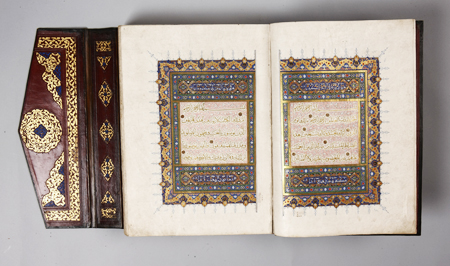
Exhibition explores royal life of Istanbul

Turkey and Korea are located on opposite sides of the globe, but the two nations have managed to forge close ties in the past half a century. Diplomatic relations began after Turkey provided crucial military support during the Korean War (1950-1953), and the bond remains strong to this day.
An exhibit has opened in Seoul to celebrate the 55th year of this somewhat unlikely pairing. Turkey has generously lent priceless artifacts from its past to the National Museum of Korea.
In content, “The Emperors of Istanbul” has little to do with the friendship between the two modern democratic countries. Rather, it reaches back to Turkey’s past, to the heyday of the Ottoman Empire (1453-1922) when sultans ruled absolutely and lived lavishly.
Before it gets to the Ottoman Empire, there is first an overview of the eras that preceded it. The ancient Hittite Empire is represented by ceramic figurines and vases dating as far back as 3,000 years.

The Eastern Roman Empire and the (fascinating) rise and fall of Constantinople are summarized by a handful of busts and sculptures.
The speed through which the exhibition runs through the first 5,000 years of Turkish history is rather dizzying. But as the title states, this is a show about the emperors of Istanbul, not Constantinople and the exhibit truly begins from when the city saw its name change.
Height of Ottoman rul
The majority of the objects on display date between the 15th and 19th century, when the Ottoman Empire was at the height of its power. The artifacts are organized categorically rather than chronologically, and the exhibit moves between the centuries and the reigns of sultans with relative ease.
The advantage of this grouping of objects is that visitors get a better feel of what the lives of the sultans might have been like. Simply put, these emperors of Istanbul lived surrounded by exquisitely beautiful things. This not only goes for the usual ornamental objects like pendants and earrings, but functional, everyday items, as well.

From candlesticks and incense burners to jugs and basins, the surface of every item is covered in jewels and intricate designs. Swords, muskets and other military equipment glitter and shine, as do the silver bath clogs used to keep the feet of royalty from touching dirty bath water.
There is a whole room devoted to the delicate utensils and bowls from which the sultans ate, as well as the coffee cups and cigarette holders they might have used after their meals. Even at their most lavish, the objects also have a practical element that keeps them from seeming too decadent.
The highlights of the exhibit are artifacts that show the important role that Islam played in the Ottoman Empire.
Prayer rugs, Qu’ran stands and storage chests and even pages of the Koran itself are on display, and they are quite beautiful to behold.
But here, the decorative aspects are used for a higher purpose, and this gives the objects a greater sense of depth and meaning.
“The Emperors of Istanbul” will run through Sept. 2 at the National Museum of Korea in downtown Seoul. Tickets are 12,000 won for adults. For more information, go to www.istanbul2012.co.kr or call 1666-4392. <Korea Times/Joon Soh>



3 comments
I have learn a few just right stuff here. Definitely value bookmarking for revisiting. I surprise how a lot effort you set to create this sort of great informative website.
thanks to the author for taking his clock time on this one.
I’d perpetually want to be update on new articles on this website , saved to favorites ! .